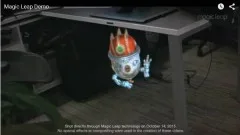During the recent WSJD Technology Event (WSJ.d Live) held in Laguna Beach, CA, Rony Abovitz , CEO of Magic Leap talked in an interview about their latest developments and further plans.
Magic Leap is the secretive company that got a load of money in its latest financing round a year ago. Back then, leading the investment was Google, who, in the process, created one of the best funded augmented reality companies in the world. As a consequence, Magic Leap is working on many basic developments for augmented reality.
During the interview, Abovitz said that they have hired over 100 people to work on their vision of augmented reality. He continued by stating that they are aiming at creating the ultimate form of augmented reality that will “not be distinguishable from real life”.
As he explained, current augmented reality is hindered by the quality of the imagery, a shortcoming that Magic Leap aims to overcome with a wavefront type display. There was no explanation on how they plan to achieve that feat, but they see this as the way to create the optimal augmented reality experience. Their goal is to create AR that does not look or feel like filmed objects, but real ones. Of course, since we are talking about visual effects this kind of realism will only affect the visual sense and not the others like taste, touch, smell, etc. Nevertheless this is already a pretty high hurdle to jump.
One other aspect of augmented reality is the development of an ‘augmented reality OS’ that will enable such demanding tasks as laid out by Magic Leap. They said that the current operating systems are not capable of supporting such a system.
 Source: Magic Leap
Source: Magic Leap
Magic Leap, has just released a new video that shows a little robot floating in mid air as shown in the picture. The video can be found on YouTube.
Analyst Comment
This is certainly the kind of goal I would see as the ultimate form of augmented reality. I hope that they will be figuring out how to make such a display and put it in a headset. Unfortunately, it also means that they have to develop a kind of display technology that simply doesn’t exist yet. While this seems to be the right goal, no available display and computer technology we have today is capable of displaying and creating wavefront images in real time.
While $500 million starting capital is a good start to achieve that goal, it is just that, a start. We will need many more companies working on the various aspects of such a system to share this vision to create anything close to this goal. (NH)

